C07J Personal Finance Assignment: Health, Investments & Planning
VerifiedAdded on 2023/05/28
|7
|1450
|237
Homework Assignment
AI Summary
This assignment delves into key aspects of personal finance. Part A discusses evaluating healthcare insurance options, emphasizing comparing different plans (HMOs, PPOs, etc.) and assessing provider networks to minimize out-of-pocket costs. It also considers the limitations and cost-effectiveness of private health insurance. Part B examines the impact of stock investments on financial planning, liquidity management, and wealth protection, highlighting how inflation can erode investment returns and affect financial stability. Part C explores risks associated with mutual fund investments, stressing the importance of understanding investment strategies, potential risks, fund costs, and historical performance before investing. The assignment underscores the need for a comprehensive financial plan that aligns with individual risk tolerance and financial goals. Desklib provides past papers and solved assignments to aid students in their studies.
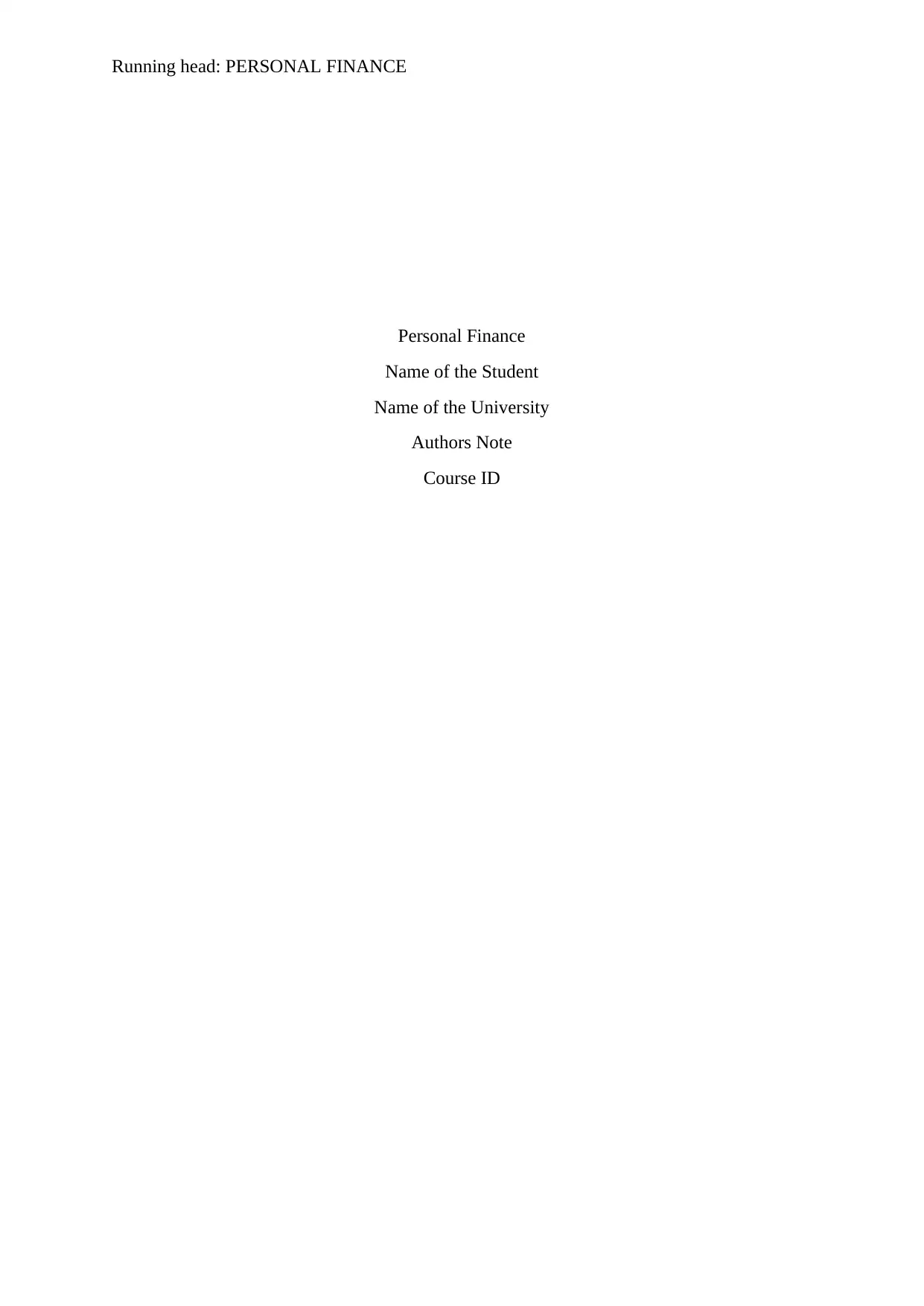
Running head: PERSONAL FINANCE
Personal Finance
Name of the Student
Name of the University
Authors Note
Course ID
Personal Finance
Name of the Student
Name of the University
Authors Note
Course ID
Paraphrase This Document
Need a fresh take? Get an instant paraphrase of this document with our AI Paraphraser
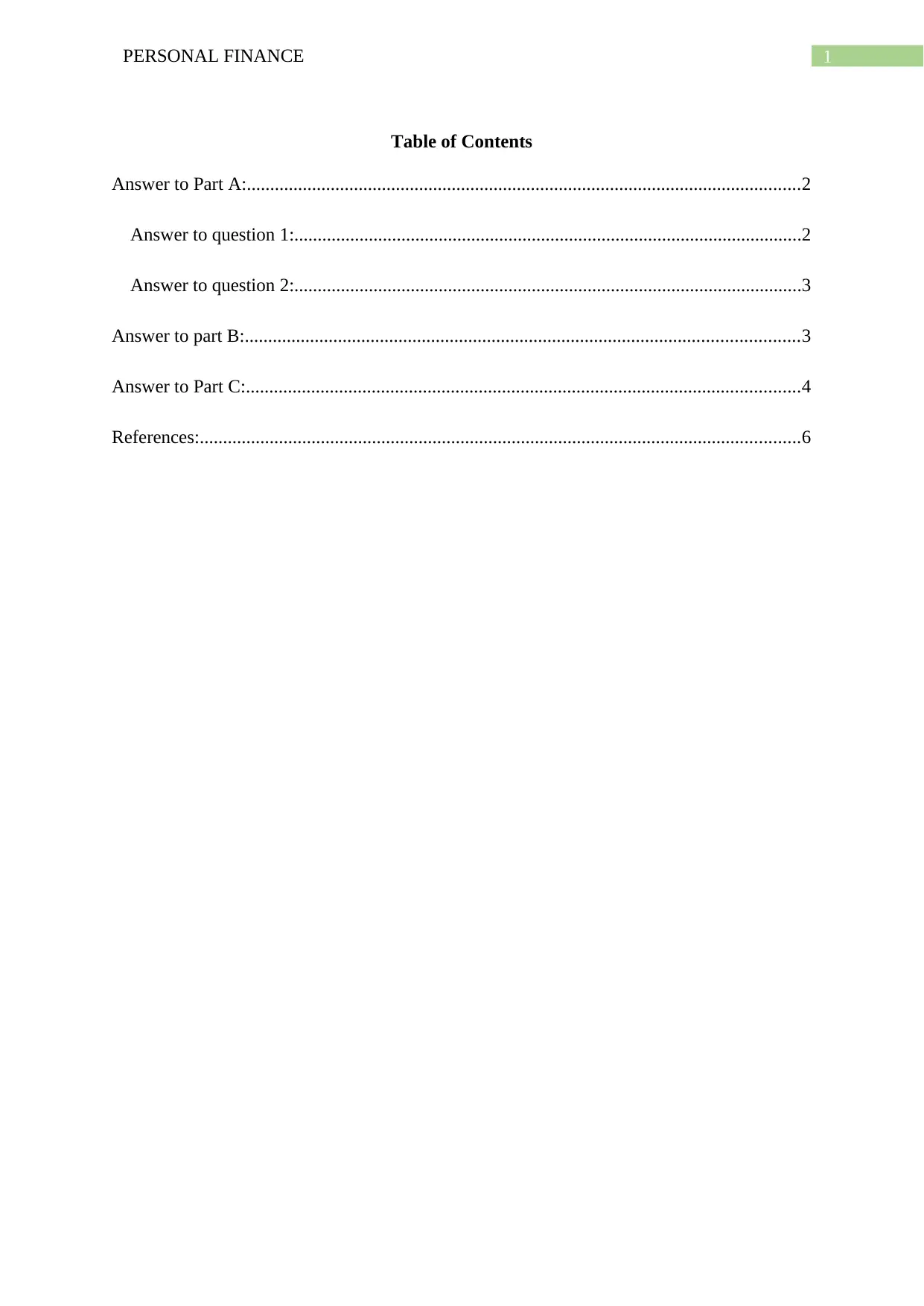
1PERSONAL FINANCE
Table of Contents
Answer to Part A:.......................................................................................................................2
Answer to question 1:.............................................................................................................2
Answer to question 2:.............................................................................................................3
Answer to part B:.......................................................................................................................3
Answer to Part C:.......................................................................................................................4
References:.................................................................................................................................6
Table of Contents
Answer to Part A:.......................................................................................................................2
Answer to question 1:.............................................................................................................2
Answer to question 2:.............................................................................................................3
Answer to part B:.......................................................................................................................3
Answer to Part C:.......................................................................................................................4
References:.................................................................................................................................6
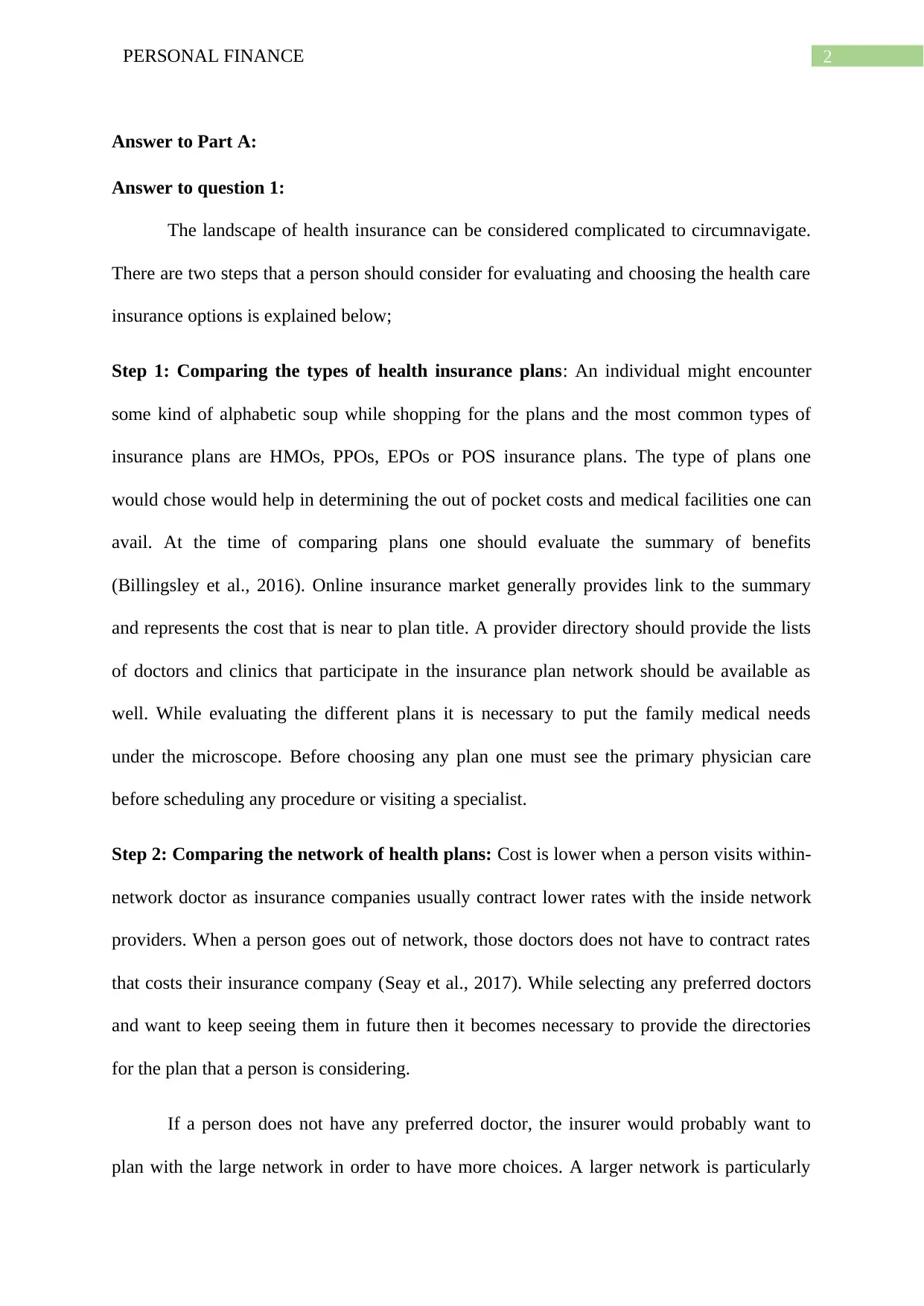
2PERSONAL FINANCE
Answer to Part A:
Answer to question 1:
The landscape of health insurance can be considered complicated to circumnavigate.
There are two steps that a person should consider for evaluating and choosing the health care
insurance options is explained below;
Step 1: Comparing the types of health insurance plans: An individual might encounter
some kind of alphabetic soup while shopping for the plans and the most common types of
insurance plans are HMOs, PPOs, EPOs or POS insurance plans. The type of plans one
would chose would help in determining the out of pocket costs and medical facilities one can
avail. At the time of comparing plans one should evaluate the summary of benefits
(Billingsley et al., 2016). Online insurance market generally provides link to the summary
and represents the cost that is near to plan title. A provider directory should provide the lists
of doctors and clinics that participate in the insurance plan network should be available as
well. While evaluating the different plans it is necessary to put the family medical needs
under the microscope. Before choosing any plan one must see the primary physician care
before scheduling any procedure or visiting a specialist.
Step 2: Comparing the network of health plans: Cost is lower when a person visits within-
network doctor as insurance companies usually contract lower rates with the inside network
providers. When a person goes out of network, those doctors does not have to contract rates
that costs their insurance company (Seay et al., 2017). While selecting any preferred doctors
and want to keep seeing them in future then it becomes necessary to provide the directories
for the plan that a person is considering.
If a person does not have any preferred doctor, the insurer would probably want to
plan with the large network in order to have more choices. A larger network is particularly
Answer to Part A:
Answer to question 1:
The landscape of health insurance can be considered complicated to circumnavigate.
There are two steps that a person should consider for evaluating and choosing the health care
insurance options is explained below;
Step 1: Comparing the types of health insurance plans: An individual might encounter
some kind of alphabetic soup while shopping for the plans and the most common types of
insurance plans are HMOs, PPOs, EPOs or POS insurance plans. The type of plans one
would chose would help in determining the out of pocket costs and medical facilities one can
avail. At the time of comparing plans one should evaluate the summary of benefits
(Billingsley et al., 2016). Online insurance market generally provides link to the summary
and represents the cost that is near to plan title. A provider directory should provide the lists
of doctors and clinics that participate in the insurance plan network should be available as
well. While evaluating the different plans it is necessary to put the family medical needs
under the microscope. Before choosing any plan one must see the primary physician care
before scheduling any procedure or visiting a specialist.
Step 2: Comparing the network of health plans: Cost is lower when a person visits within-
network doctor as insurance companies usually contract lower rates with the inside network
providers. When a person goes out of network, those doctors does not have to contract rates
that costs their insurance company (Seay et al., 2017). While selecting any preferred doctors
and want to keep seeing them in future then it becomes necessary to provide the directories
for the plan that a person is considering.
If a person does not have any preferred doctor, the insurer would probably want to
plan with the large network in order to have more choices. A larger network is particularly
⊘ This is a preview!⊘
Do you want full access?
Subscribe today to unlock all pages.

Trusted by 1+ million students worldwide
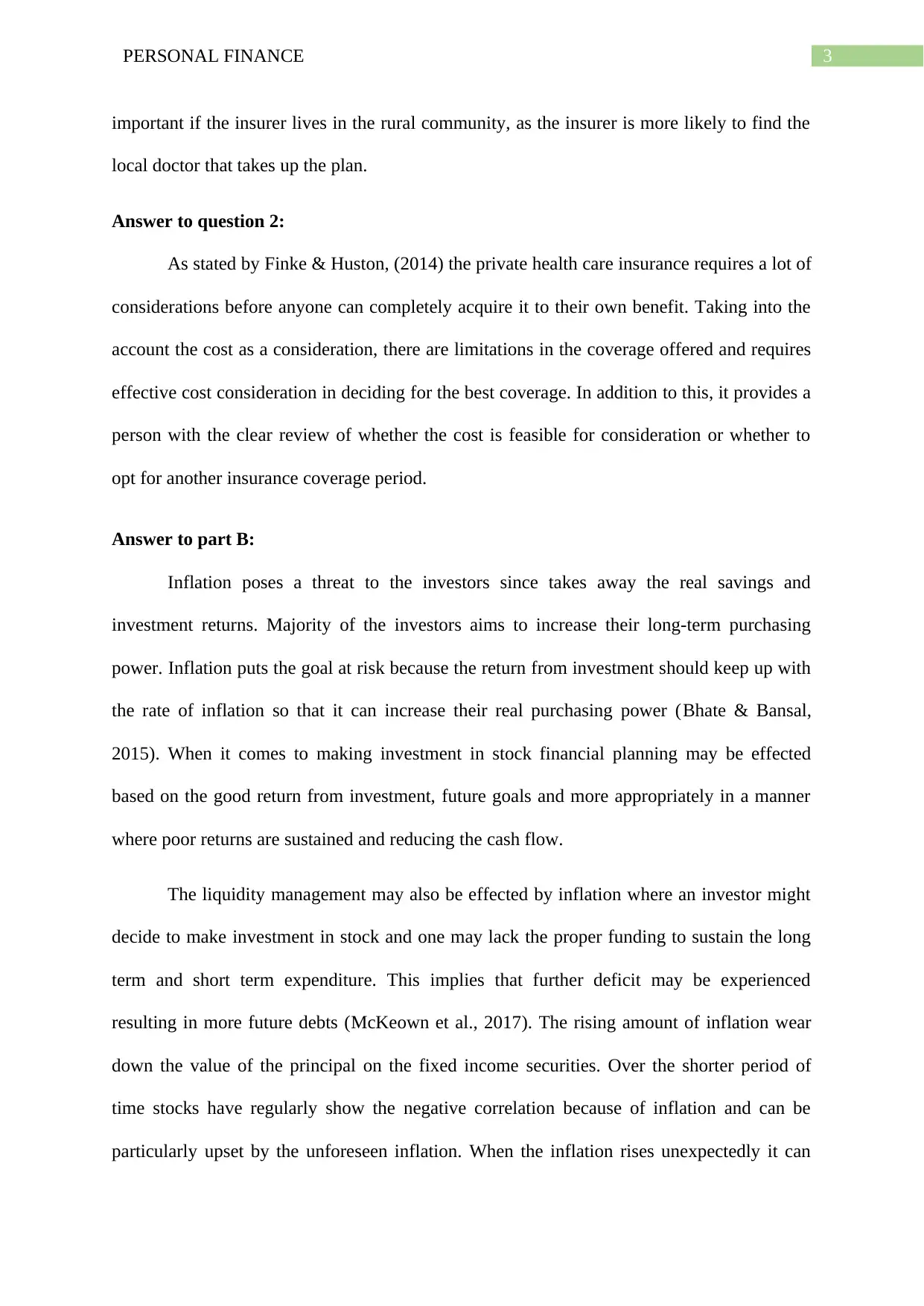
3PERSONAL FINANCE
important if the insurer lives in the rural community, as the insurer is more likely to find the
local doctor that takes up the plan.
Answer to question 2:
As stated by Finke & Huston, (2014) the private health care insurance requires a lot of
considerations before anyone can completely acquire it to their own benefit. Taking into the
account the cost as a consideration, there are limitations in the coverage offered and requires
effective cost consideration in deciding for the best coverage. In addition to this, it provides a
person with the clear review of whether the cost is feasible for consideration or whether to
opt for another insurance coverage period.
Answer to part B:
Inflation poses a threat to the investors since takes away the real savings and
investment returns. Majority of the investors aims to increase their long-term purchasing
power. Inflation puts the goal at risk because the return from investment should keep up with
the rate of inflation so that it can increase their real purchasing power (Bhate & Bansal,
2015). When it comes to making investment in stock financial planning may be effected
based on the good return from investment, future goals and more appropriately in a manner
where poor returns are sustained and reducing the cash flow.
The liquidity management may also be effected by inflation where an investor might
decide to make investment in stock and one may lack the proper funding to sustain the long
term and short term expenditure. This implies that further deficit may be experienced
resulting in more future debts (McKeown et al., 2017). The rising amount of inflation wear
down the value of the principal on the fixed income securities. Over the shorter period of
time stocks have regularly show the negative correlation because of inflation and can be
particularly upset by the unforeseen inflation. When the inflation rises unexpectedly it can
important if the insurer lives in the rural community, as the insurer is more likely to find the
local doctor that takes up the plan.
Answer to question 2:
As stated by Finke & Huston, (2014) the private health care insurance requires a lot of
considerations before anyone can completely acquire it to their own benefit. Taking into the
account the cost as a consideration, there are limitations in the coverage offered and requires
effective cost consideration in deciding for the best coverage. In addition to this, it provides a
person with the clear review of whether the cost is feasible for consideration or whether to
opt for another insurance coverage period.
Answer to part B:
Inflation poses a threat to the investors since takes away the real savings and
investment returns. Majority of the investors aims to increase their long-term purchasing
power. Inflation puts the goal at risk because the return from investment should keep up with
the rate of inflation so that it can increase their real purchasing power (Bhate & Bansal,
2015). When it comes to making investment in stock financial planning may be effected
based on the good return from investment, future goals and more appropriately in a manner
where poor returns are sustained and reducing the cash flow.
The liquidity management may also be effected by inflation where an investor might
decide to make investment in stock and one may lack the proper funding to sustain the long
term and short term expenditure. This implies that further deficit may be experienced
resulting in more future debts (McKeown et al., 2017). The rising amount of inflation wear
down the value of the principal on the fixed income securities. Over the shorter period of
time stocks have regularly show the negative correlation because of inflation and can be
particularly upset by the unforeseen inflation. When the inflation rises unexpectedly it can
Paraphrase This Document
Need a fresh take? Get an instant paraphrase of this document with our AI Paraphraser
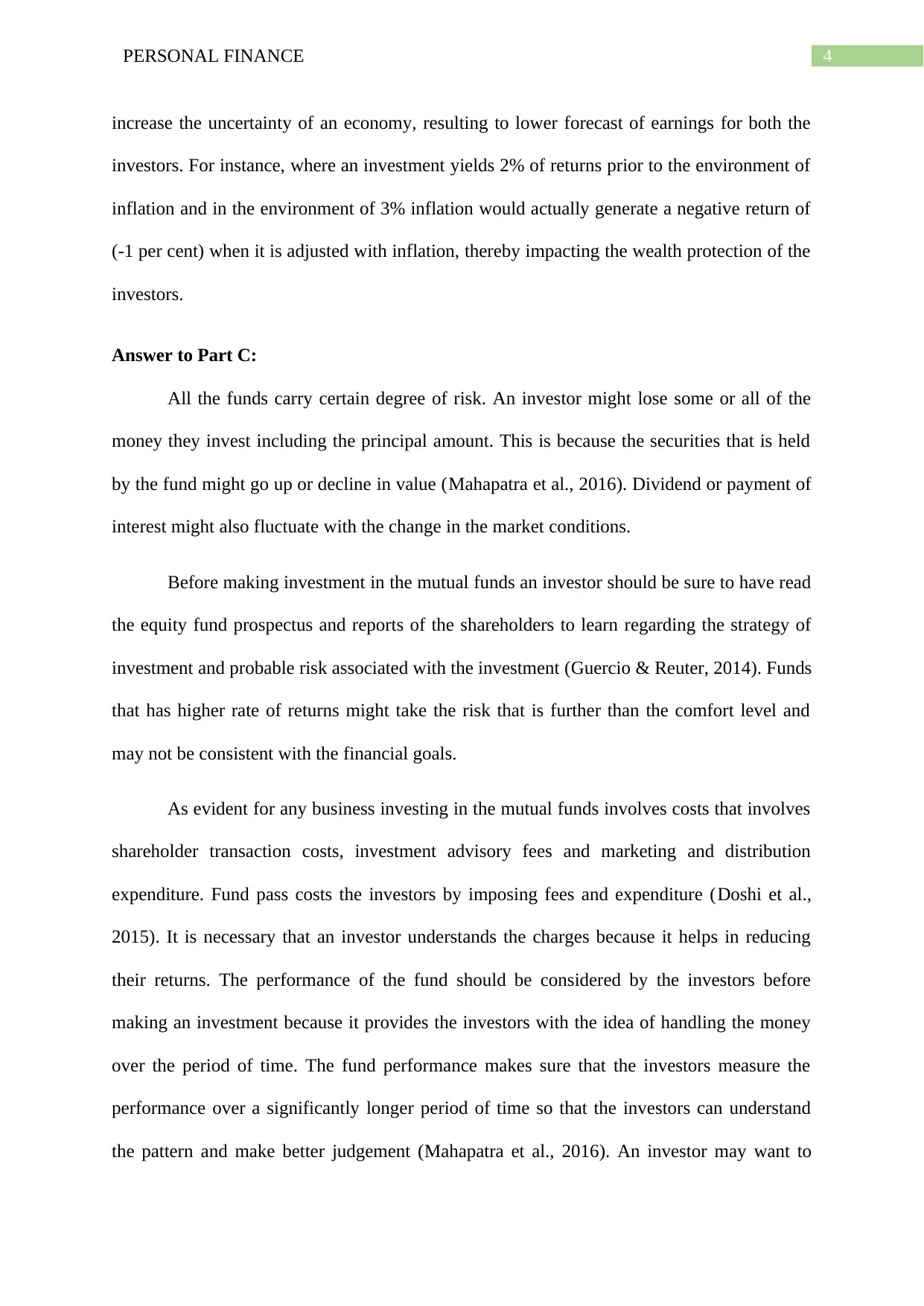
4PERSONAL FINANCE
increase the uncertainty of an economy, resulting to lower forecast of earnings for both the
investors. For instance, where an investment yields 2% of returns prior to the environment of
inflation and in the environment of 3% inflation would actually generate a negative return of
(-1 per cent) when it is adjusted with inflation, thereby impacting the wealth protection of the
investors.
Answer to Part C:
All the funds carry certain degree of risk. An investor might lose some or all of the
money they invest including the principal amount. This is because the securities that is held
by the fund might go up or decline in value (Mahapatra et al., 2016). Dividend or payment of
interest might also fluctuate with the change in the market conditions.
Before making investment in the mutual funds an investor should be sure to have read
the equity fund prospectus and reports of the shareholders to learn regarding the strategy of
investment and probable risk associated with the investment (Guercio & Reuter, 2014). Funds
that has higher rate of returns might take the risk that is further than the comfort level and
may not be consistent with the financial goals.
As evident for any business investing in the mutual funds involves costs that involves
shareholder transaction costs, investment advisory fees and marketing and distribution
expenditure. Fund pass costs the investors by imposing fees and expenditure (Doshi et al.,
2015). It is necessary that an investor understands the charges because it helps in reducing
their returns. The performance of the fund should be considered by the investors before
making an investment because it provides the investors with the idea of handling the money
over the period of time. The fund performance makes sure that the investors measure the
performance over a significantly longer period of time so that the investors can understand
the pattern and make better judgement (Mahapatra et al., 2016). An investor may want to
increase the uncertainty of an economy, resulting to lower forecast of earnings for both the
investors. For instance, where an investment yields 2% of returns prior to the environment of
inflation and in the environment of 3% inflation would actually generate a negative return of
(-1 per cent) when it is adjusted with inflation, thereby impacting the wealth protection of the
investors.
Answer to Part C:
All the funds carry certain degree of risk. An investor might lose some or all of the
money they invest including the principal amount. This is because the securities that is held
by the fund might go up or decline in value (Mahapatra et al., 2016). Dividend or payment of
interest might also fluctuate with the change in the market conditions.
Before making investment in the mutual funds an investor should be sure to have read
the equity fund prospectus and reports of the shareholders to learn regarding the strategy of
investment and probable risk associated with the investment (Guercio & Reuter, 2014). Funds
that has higher rate of returns might take the risk that is further than the comfort level and
may not be consistent with the financial goals.
As evident for any business investing in the mutual funds involves costs that involves
shareholder transaction costs, investment advisory fees and marketing and distribution
expenditure. Fund pass costs the investors by imposing fees and expenditure (Doshi et al.,
2015). It is necessary that an investor understands the charges because it helps in reducing
their returns. The performance of the fund should be considered by the investors before
making an investment because it provides the investors with the idea of handling the money
over the period of time. The fund performance makes sure that the investors measure the
performance over a significantly longer period of time so that the investors can understand
the pattern and make better judgement (Mahapatra et al., 2016). An investor may want to
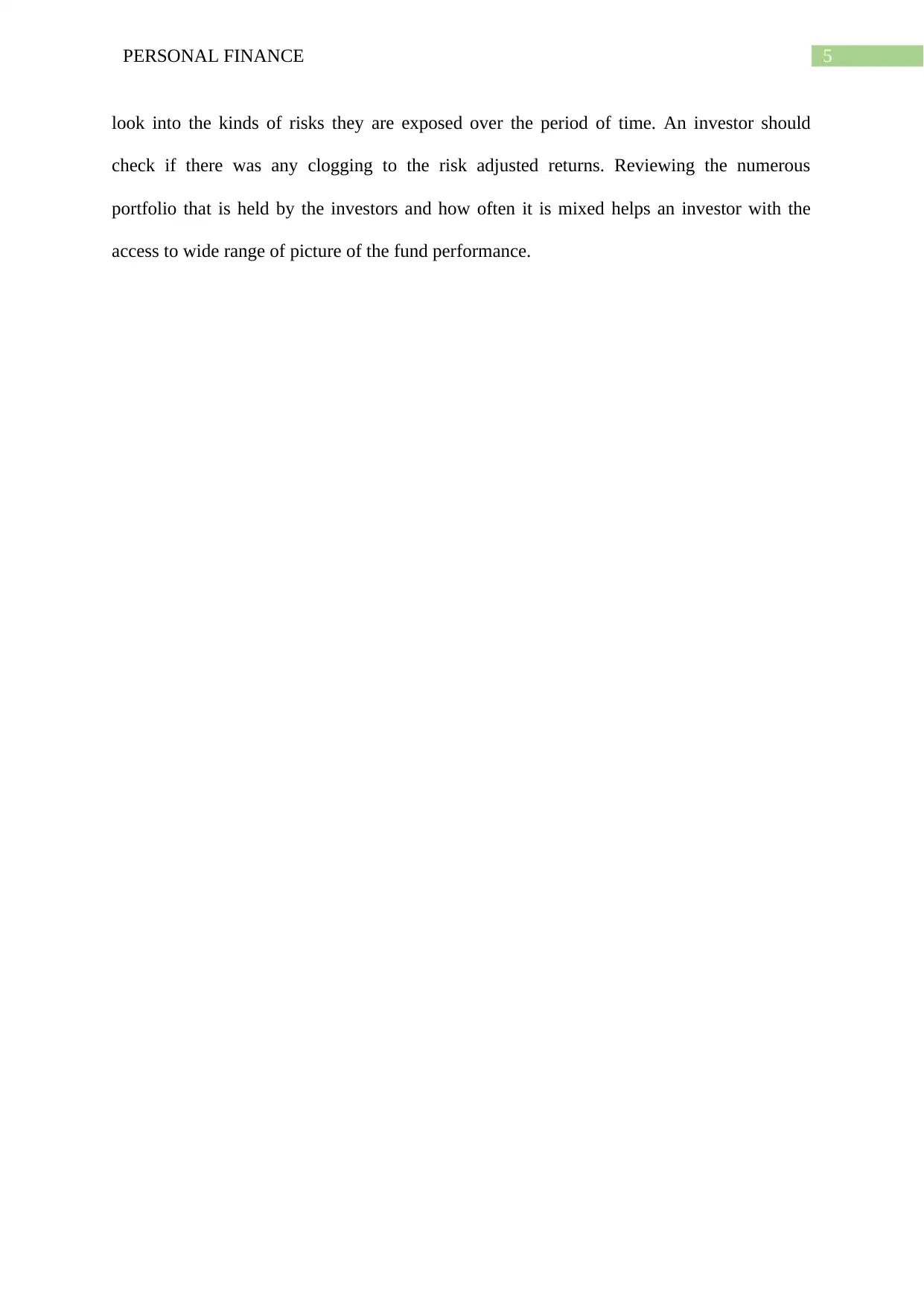
5PERSONAL FINANCE
look into the kinds of risks they are exposed over the period of time. An investor should
check if there was any clogging to the risk adjusted returns. Reviewing the numerous
portfolio that is held by the investors and how often it is mixed helps an investor with the
access to wide range of picture of the fund performance.
look into the kinds of risks they are exposed over the period of time. An investor should
check if there was any clogging to the risk adjusted returns. Reviewing the numerous
portfolio that is held by the investors and how often it is mixed helps an investor with the
access to wide range of picture of the fund performance.
⊘ This is a preview!⊘
Do you want full access?
Subscribe today to unlock all pages.

Trusted by 1+ million students worldwide
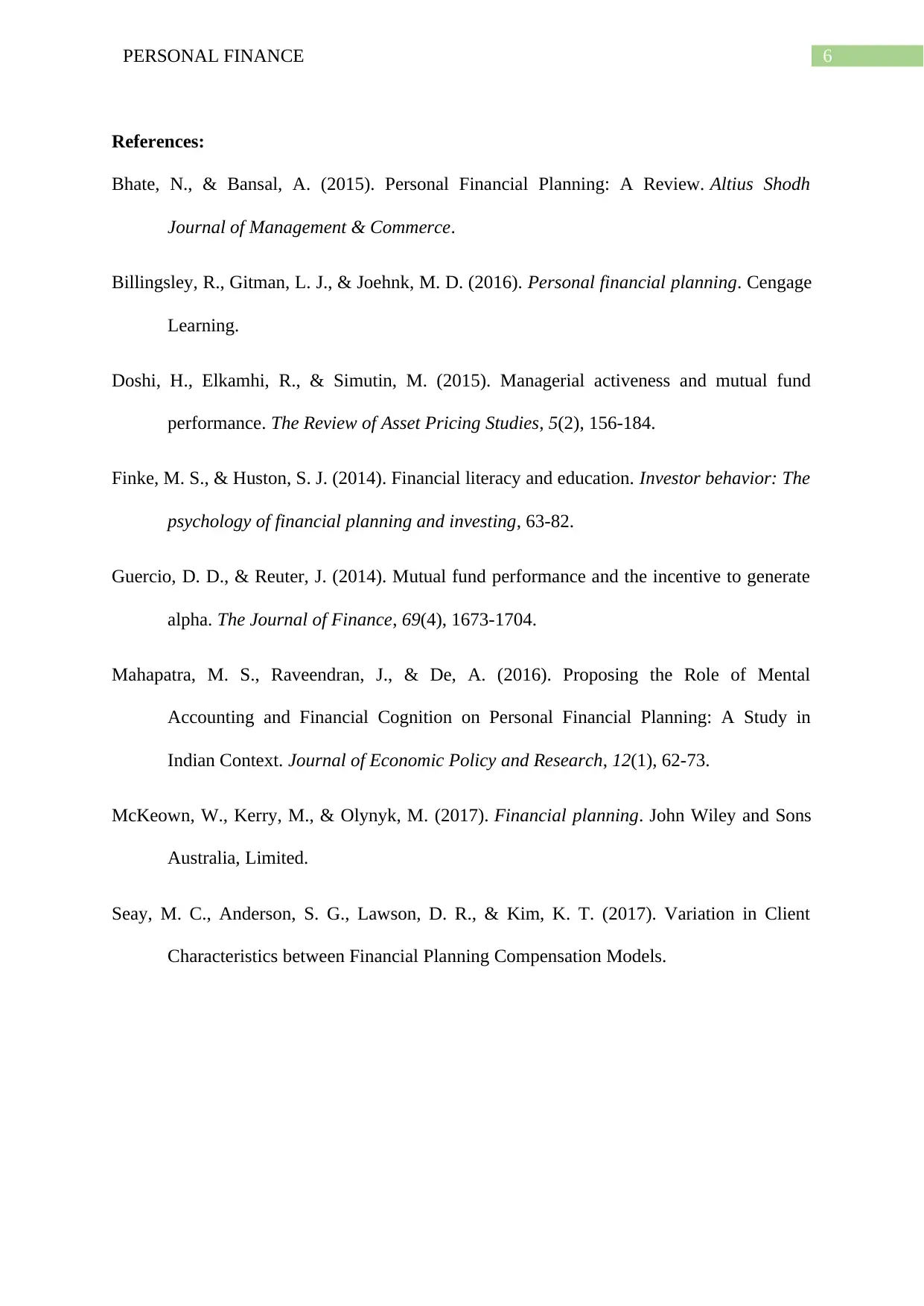
6PERSONAL FINANCE
References:
Bhate, N., & Bansal, A. (2015). Personal Financial Planning: A Review. Altius Shodh
Journal of Management & Commerce.
Billingsley, R., Gitman, L. J., & Joehnk, M. D. (2016). Personal financial planning. Cengage
Learning.
Doshi, H., Elkamhi, R., & Simutin, M. (2015). Managerial activeness and mutual fund
performance. The Review of Asset Pricing Studies, 5(2), 156-184.
Finke, M. S., & Huston, S. J. (2014). Financial literacy and education. Investor behavior: The
psychology of financial planning and investing, 63-82.
Guercio, D. D., & Reuter, J. (2014). Mutual fund performance and the incentive to generate
alpha. The Journal of Finance, 69(4), 1673-1704.
Mahapatra, M. S., Raveendran, J., & De, A. (2016). Proposing the Role of Mental
Accounting and Financial Cognition on Personal Financial Planning: A Study in
Indian Context. Journal of Economic Policy and Research, 12(1), 62-73.
McKeown, W., Kerry, M., & Olynyk, M. (2017). Financial planning. John Wiley and Sons
Australia, Limited.
Seay, M. C., Anderson, S. G., Lawson, D. R., & Kim, K. T. (2017). Variation in Client
Characteristics between Financial Planning Compensation Models.
References:
Bhate, N., & Bansal, A. (2015). Personal Financial Planning: A Review. Altius Shodh
Journal of Management & Commerce.
Billingsley, R., Gitman, L. J., & Joehnk, M. D. (2016). Personal financial planning. Cengage
Learning.
Doshi, H., Elkamhi, R., & Simutin, M. (2015). Managerial activeness and mutual fund
performance. The Review of Asset Pricing Studies, 5(2), 156-184.
Finke, M. S., & Huston, S. J. (2014). Financial literacy and education. Investor behavior: The
psychology of financial planning and investing, 63-82.
Guercio, D. D., & Reuter, J. (2014). Mutual fund performance and the incentive to generate
alpha. The Journal of Finance, 69(4), 1673-1704.
Mahapatra, M. S., Raveendran, J., & De, A. (2016). Proposing the Role of Mental
Accounting and Financial Cognition on Personal Financial Planning: A Study in
Indian Context. Journal of Economic Policy and Research, 12(1), 62-73.
McKeown, W., Kerry, M., & Olynyk, M. (2017). Financial planning. John Wiley and Sons
Australia, Limited.
Seay, M. C., Anderson, S. G., Lawson, D. R., & Kim, K. T. (2017). Variation in Client
Characteristics between Financial Planning Compensation Models.
1 out of 7
Related Documents
Your All-in-One AI-Powered Toolkit for Academic Success.
+13062052269
info@desklib.com
Available 24*7 on WhatsApp / Email
![[object Object]](/_next/static/media/star-bottom.7253800d.svg)
Unlock your academic potential
Copyright © 2020–2025 A2Z Services. All Rights Reserved. Developed and managed by ZUCOL.





